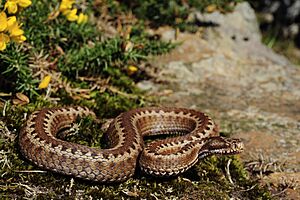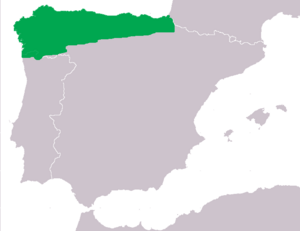Vipera seoanei facts for kids
Quick facts for kids Vipera seoanei |
|
|---|---|
 |
|
| Conservation status | |
| Scientific classification | |
| Genus: |
Vipera
|
| Species: |
seoanei
|
 |
|
| Distribution of Vipera seoanei. | |
| Synonyms | |
|
|
The Seoane's viper (scientific name: Vipera seoanei) is a type of venomous snake. It is found only in a specific area of Europe. This includes the very southwestern part of France and the northern areas of Spain and Portugal.
People also call this snake by other names, like the Baskian viper, Iberian cross adder, or Portuguese viper. There are two main types, or subspecies, of this viper that scientists recognize.
Contents
About the Seoane's Viper's Name
The scientific name, seoanei, was chosen to honor a Spanish naturalist named Víctor López Seoane y Pardo-Montenegro. Naturalists are scientists who study nature.
What Does the Seoane's Viper Look Like?
Adult Seoane's vipers can grow up to about 75 cm (30 in) long, including their tail. However, they are usually a bit shorter than that.
These snakes are very interesting because they can have many different colors and patterns. Scientists have described four main types of patterns:
- Type A: These snakes have a clear, brown zigzag pattern running down their back. This pattern looks a lot like the common European adder (Vipera berus). The zigzag stands out against a light background, like beige or light gray.
- Type B: This type has a pattern that looks like two stripes. The main color of the snake appears as two thin, straight lines along its body. It can look a bit like another snake called Vipera kaznakovi.
- Type C: Some Seoane's vipers are a plain brownish color. They do not have any special patterns on their body.
- Type D: This pattern is a zigzag, but it's broken up or fragmented. It doesn't look like a continuous line.
Where Does the Seoane's Viper Live?
The Seoane's viper lives in the far southwestern part of France. It also lives in the northern regions of Spain and Portugal.
The first place where this snake was officially found and described was in the mountains of Galicia and Cantabrici in Spain. Today, scientists believe the exact spot was near Ferrol in the A Coruña province of northwestern Spain.
Is the Seoane's Viper in Danger?
The Seoane's viper is currently listed as "Least Concern" (LC) by the IUCN Red List of Threatened Species. This means that scientists believe the snake is not in immediate danger of disappearing.
It has this status for a few reasons:
- It lives in a fairly wide area.
- There are thought to be many of these snakes.
- Its population is not decreasing quickly enough to be considered threatened.
Even though it's "Least Concern," the Seoane's viper is still a protected animal. It is listed under Appendix III of the Berne Convention. This agreement helps protect wildlife and their natural homes in Europe.
Different Types of Seoane's Viper
There are two recognized subspecies (or types) of the Seoane's viper. Subspecies are groups of animals within the same species that have slight differences and live in different areas.
| Subspecies Name | Who Described It | Where It Lives |
|---|---|---|
| V. s. cantabrica | Braña & Bas, 1983 | The Cantabrian Mountains in northern Spain. |
| V. s. seoanei | Lataste, 1879 | Extreme southwestern France and the northern regions of Spain and Portugal. |


